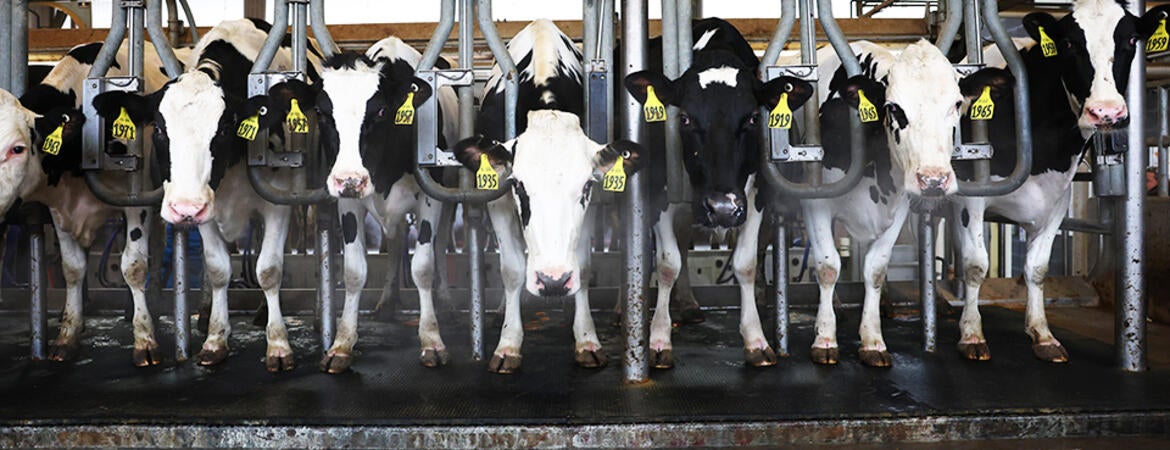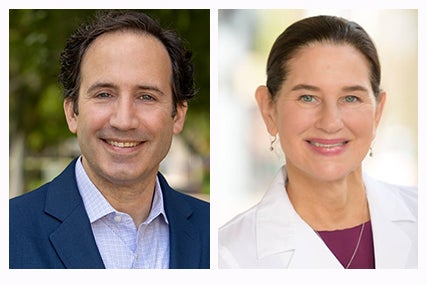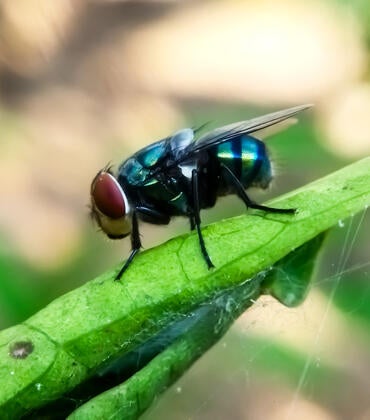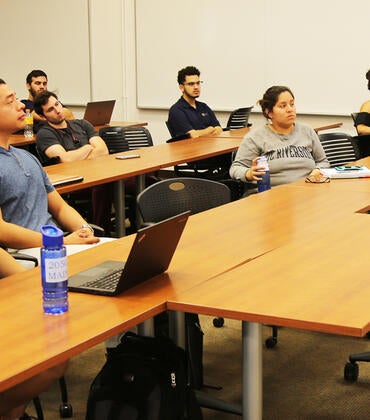
While a pandemic is not inevitable, the spread of the bird flu virus, also known as H5N1, has surpassed worrisome milestones in the United States. In the past year, many chicken flocks at poultry farms have been decimated, sending egg prices soaring. Hundreds of cattle herds have also been infected, and cattle in Idaho have been infected twice within a year. In the U.S., the virus has infected at least 67 people in 2024, compared to just one person in 2023 and 2022.
Here, we asked UC Riverside public policy professor Richard Carpiano and medical school professor Dr. Elizabeth Jacobs to discuss the policy response and medical issues concerning the bird flu threat. Carpiano is a health policy expert and co-chair of a panel convened by the medical journal The Lancet to help communities worldwide prevent and prepare for pandemics and other threats. Dr. Jacobs is an internal medicine physician and chair of the Department of Internal Medicine at UCR Health.
Question: What are the chances that H5N1 could evolve into a virus that spreads efficiently among humans?
Dr. Jacobs: Public health officials are very concerned about this possibility. Those who study the epidemiology of viruses note that the virus that causes bird flu, H5N1, is following the same path that other viruses have taken to become one that spreads efficiently in humans. This includes continued spread among animals, increasing numbers of humans infected by animals, and the detection of several new versions of the virus, particularly in the two patients in the U.S. who had severe illness.
Q: How easily does the virus spread from an infected animal to a human?
Dr. Jacobs: The most important thing to know is that bird flu spreads from infected animals to humans, so anyone who works with animals is at high risk of infection (birds, cattle, veterinary settings) or has an infected animal must take precautions to avoid infection. We know the virus can be contracted from close contact or handling of infected animals and from surfaces contaminated with sick birds. It is not easily spread outside these situations.
Q: Some cattle in Idaho reportedly have been infected twice within the same year. Why is this milestone concerning?
Dr. Jacobs: The concerning part is that it means that the bird flu virus (H5N1) continues to circulate and may continue in this way indefinitely. As this circulation occurs, there are many opportunities for the virus to mutate, which naturally happens among viruses, into forms that are more dangerous, including evolving into a form that can be spread between people. Right now, people only get infected by exposure to infected cattle, birds, and other animals. It can be spread between animals but not between humans yet. If there is a person-to-person spread, it would spread rapidly among humans.
Q: What lessons from COVID-19 should be applied to a potential H5N1 pandemic?
Carpiano: Most fundamentally, COVID-19 showed Americans how we need to think about human health and disease risk. Thanks to decades of achievements from public health investments, we have become accustomed to non-infectious diseases (like cancer, heart disease, and diabetes) being our major health threats. But COVID-19 provided the U.S. with a stark reminder of the serious threats that new and emerging infectious diseases pose to our nation’s health and prosperity. Thankfully, H5N1 has not gotten to the point of human-to-human spread and let us hope it stays that way. But with the focus on disease spread among wild birds and livestock (chicken and cows), H5N1 highlights (screams about) a related matter how our health is also importantly tied to our ecosystem and animal health and how threats that occur to the animal world can certainly impact us. This connection matters not just for animal-to-human infection transmission risks we have seen for H5N1 among farm workers, but for our economy too. The frustration over the H5N1-caused price increase in eggs—a common American food staple—is a prime example of how animal epidemics can have significant human impacts.
Q: What are the similarities between the spread of COVID-19 and H5N1?
Carpiano: COVID-19 and now H5N1 highlight two key things: The first is how our nation and the globalized, interdependent world of which it is part, are facing an increase in threats from infectious diseases. The second is the urgent need to invest in public health and other systems in ways that can help local communities and entire nations be more resilient to these threats whenever they arise. The COVID-19 pandemic took a heavy toll on the US, but it did result in a focus on mobilizing knowledge about existing and emerging technologies (e.g., vaccines, rapid tests, predictive disease modeling techniques, and data systems), and other resources, such as cross-sector collaborations, and supply chain logistics. These many instances (some occurring just in specific states or local communities) provide valuable case studies that can be used to inform policies and practices for creating such resilience: to better identify such threats and minimize their many human, social, and economic impacts on local communities.
Q: What are the biggest obstacles to public trust in government-led disease prevention efforts?
Carpiano: Such government-led efforts face many challenges in ensuring public trust. Two of the biggest are misinformation and politicization. Misinformation emerges in any crisis and can quickly pollute government communication, which is vital for public confidence. In the social media age, it is increasingly easier for such misinformation to spread and very challenging to counter once it does.
This is why it is so important for local, state, and federal agencies to have coordinated, timely, and clear communication efforts, especially as a situation like H5N1 is unfolding. These efforts are key for establishing public trust that the situation is being competently attended to and is being given the attention it requires. Such ongoing practices can even help minimize the influence of misinformation that may circulate as the situation unfolds.
Politicization refers to the increasing trend of bringing unhelpful partisan politics into discussions of science and public health. A pathogen does not care what political party you voted for. Politicization has had tragic consequences for public and elected official support of longstanding, effective public health programs and recommendations.
Q: How can the Trump administration impact public trust?
Carpiano: The current transition to a new federal administration is especially significant for public trust of the H5N1 response and future public health threats that our nation will encounter in the next four years. Notably, the potential appointment of Robert F. Kennedy Jr. as Secretary of Health and Human Services will certainly impact such trust. In that role, he will have responsibility for overseeing many federal agencies that every American depends on for handling typical public health matters and new threats when they emerge. However, RFK Jr. has an extensive record of anti-science and anti-public health statements and actions related to various matters like vaccines and drinking unpasteurized milk—both of which are relevant to the H5N1 in terms of potential risk of infection and means to prevent it. He has also expressed his preference for the U.S. to focus less attention on infectious diseases. Thus, it is unclear how he might lead during a public health threat.
Q: How can health officials improve outreach to farmworkers, especially those who may fear immigration or employment consequences?
Carpiano: Farmworkers face a H5N1 double bind: they are at greatest risk of infection due to being in regular contact with infected animals and yet are likely to remain silent about their situation for fear of being fired and/or reported to immigration agencies for raising concern or simply being viewed as “causing trouble.” The current immigration enforcement efforts are not helping in best responding to this public health problem and helping people who might be sick.
Such a situation highlights the potential importance of two measures: One option is reaching out to farm workers outside of the work setting to conduct health checks and/or educate them on the risks and how to minimize them. Here is where partnerships with civic and non-profit organizations serving their communities can be an important ally for communicating important messages.
Another option is the government agency use of incentives to get farmers to cooperate with them in controlling the disease. Agencies can pay farm owners for animal testing and reporting livestock sickness and deaths associated with H5N1 and compensate farmers for losses they incur from livestock lost to control the disease. This is an indirect way to help farm workers. Doing so could encourage farmers to stay on top of the problem and thus help minimize farm workers’ exposure to sick animals.
Q: What can you do to prevent infection?
Dr. Jacobs: If you work in the dairy, chicken, or other industry you need to take more precautions than others. That includes using personal protective equipment such as masks, goggles, and disposable foot, head, and clothing covers when in high-risk situations. You can also decontaminate yourself by showering and putting on clean clothes and shoes. High-risk situations include working with poultry, cattle, raw milk, surfaces that might be contaminated, and sick animals.
The average person can prevent infection by not handling sick or dead animals you might see or find in the wild, particularly birds, taking additional protections as listed for workers if you have chicken or pigeon coops, and not using raw milk. Milk from an infected dairy cow has one of the highest concentrations of the virus and may lead to infection by getting droplets in your eyes or inhaling them.
Q: What treatments are available for people who become infected?
Dr. Jacobs: The current treatment is with an anti-viral medicine from a family of drugs called neuraminidase inhibitors; it should be started as soon as someone is suspected to have bird flu. Most people who are infected have very mild cold-like symptoms and/or eye redness and discharge and can be treated at home; for those who have had more severe disease, they should also be treated with an anti-retroviral and receive supportive hospital treatment.




